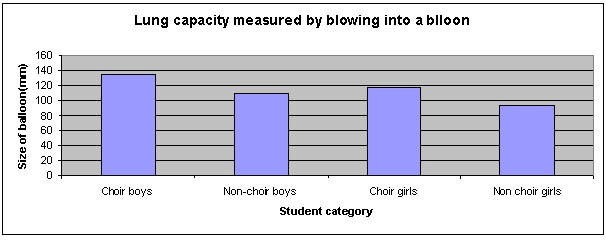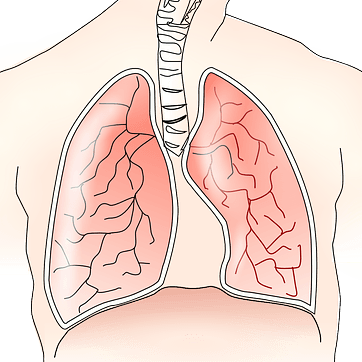| Complexity level: | 4 |
| Project cost ($): | 20 |
| Time required: | 1 day to prepare, 1 day for the experiment |
| Material availability: | Easily found |
| Safety concerns: | None |
Hypothesis
Choir singers will have greater lung capacity than non-singers.
Overview
Human Lung
Lungs are part of the human respiratory system. All humans have two lungs which consist of blood capillaries, bronchioles and alveoli. Our lungs are protected by our rib cages which consist of 12 pairs of bones. The breathing process consists of inhalation, which is the process by which our lungs are filled with air, and exhalation, which is the expelling of air from our lungs.
When air is inhaled into the lungs, the following events take place:
- Oxygen in the alveoli will be transferred into our blood capillaries and red blood cell will then transport them to other parts of the body.
- carbon dioxide transferred is transferred from other parts of our bodies to the red blood cells.
- the red blood cells return to the capillaries in the alveoli to release the carbon dioxide and absorb oxygen again.
This is why we breathe in oxygen and breathe out carbon dioxide.
Lung capacity
The term"lung capacity" refers to the amount of air a person lung can hold. The lung capacity of an average person is about 4000 to 6000 cm3. However, only a third of this capacity is normally used. When strenuous work is being done, the body will require more oxygen and the air intake in the lungs will be increased.
Athletes, wind instrument musicians and singers are known to have higher lung capacities compared to a normal person. This does not mean their lungs are bigger. Their chest muscles are stronger allowing them to expand their chests more in order to increase the air intake and to contract the chests more to exhale more air.
Scientific Terms
Materials
The materials required for this experiment:
- 5 boys and 5 girls age 15 all of whom have been members of the school choir for at least a year
- 5 boys and 5 girls age 15 and are not in the school choir, and who are not athletes
- 60 balloons
- 1 ruler / measuring tape
- 1 nose plug / swimmer nose clip
Procedure
- For this experiment, the independent variable is the type of singer (whether or not the singer is a member of the school choir.) The dependent variable is the singer's lung capacity, which is measured by the size of the balloon blown. This is determined by measuring the size of the balloon using a ruler / measuring tape. The constants (control variables) are the age of the students, the type/brand of balloon used for the experiment and the room temperature and weather conditions.
- The 1st student is asked to take a deep breath and hold his breadth.
- Then a nose plug / clip is used to close off the student nostrils.
- Give the student an deflated balloon and have him blow as much air as he can into the balloon without inhaling again.
- Measure the diameter of the balloon using the ruler/measuring tape and record the results in the table below.
- Remove the nose clip / plug.
- Procedures 2 to 6 are repeated for the other 19 students. The procedure should be done on the same day, all at once (ie: in the morning), and in the same room, to ensure that the temperature and other room conditions are constant for each student. Have them blow into the same type of balloon. Record all measurements in the table below.

Results
The results show that the choir members were able to inflate the balloons to a larger size, as compared to the non-singers. Therefore the choir students were found to have bigger lung capacities. It was also ascertained that boys have a bigger lung capacity then girls.

Use the below graph to plot the results in the above table.

Conclusion
The hypothesis that choir singer will have greater lung capacity than non-singers is proven to be true. Through training, the students were able to strengthen their chest muscles to inhale and exhale more air and therefore increase their lung capacity.
The capacity of our lungs indicates the condition of our health. All of the cells in our body require oxygen therefore it is very important to keep our lungs healthy. Activities like smoking, which reduce our lung capacity must be avoided
Also consider
The experiment can be repeated by athletes instead of choir singers.
Try to repeat the experiment using a spirometer instead of balloons to measure lung capacity.
References
- What should I know about lung capacity - http://www.wisegeek.com/what-should-i-know-about-lung-capacity.htm

